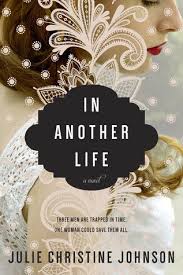In Another Life: A Novel
- By Julie Christine Johnson
- Sourcebooks Landmark
- 368 pp.
- Reviewed by Ann McClellan
- February 5, 2016
A tale of redemption, love, and time-travel in the South of France

First-time novelist Julie Christine Johnson’s In Another Life offers a tale that spans time, bringing the 13th century and contemporary Languedoc and Paris to vibrant life. Populated by characters grappling with common human challenges, this novel is amplified by a framework beyond time.
These universal themes include: What does it mean to love and be loved? What are the costs and rewards of forgiveness and atonement? How do our beliefs refract what we perceive? How does the past affect us, consciously or beyond our knowing? What is the truth and can history reveal it? These questions are explored through a kaleidoscopic reading experience. Revelations come to light as if seen through ever-shifting prisms, the lenses created by the characters’ experiences and assumptions.
Beautiful, bookish, historian Lia Carrer returns to Languedoc after her husband’s tragic death propels her into a paralyzing depression. Lia’s academic interest is in the Cathars, a Christian sect considered heretical by the Roman Catholic Church that arose in the South of France in the late Middle Ages. The author entwines Lia’s story with theirs — interspersing, juxtaposing, and sometimes overlapping 13th-century people with those of modern times.
As Lia convalesces, she’s inspired by the land of Languedoc, whose features, people, food, and wine she adores. She falls in love with Raoul, one of three men who exist outside of time. The way in which she uncovers the stories of these men is connected through the very murder that triggered the cruel and horrifying genocide of the Cathars.
Be forewarned, the author uses strong elements of fantasy, which might annoy some more literal-minded historic-fiction fans. Accepting the conceit that beings can exist outside the normally accepted construct of time allows for thought-provoking, if occasionally confusing, plot twists and turns, rewarding the persevering reader.
Languedoc, then and now, is conjured with vivid language involving all the senses, especially regarding its landscape, food, and wines. Those who have visited the area will enjoy the memories evoked, and would-be travelers will be tempted to hop on the next airplane. This specificity makes it easy to believe Lia when she says, “I accept that there are spirits here in Languedoc. Spirits from another time whose stories are part of mine. The suspension of disbelief doesn’t seem like such a tall order, surrounded by the ghosts of history.”
History itself plays a role in the story as Lia seeks to uncover the truth about the 13th-century murder and the men connected to it. Different perspectives reveal alternate versions of what could be the truth. As one of them says, “What seemed like legend carried through time on the flimsy backs of folk tales and rumor now appears plausible as history.”
It is up to Lia to discern facts from imagination. She is fearless in her pursuit of the truth, saying, “If I believed the past was too distant to matter, I wouldn’t be a historian…Revealing the truth is my life’s work. It’s never too late.”
But as another character says, “Be careful whose truth you reveal. You may come face-to-face with your own.”
The author excels at capturing the manifestations of grief and other intense emotions. For example, she writes of falling in love, “How does a heart stop and race at the same time? Words left her, replaced by desire, anger and a sudden shyness. Lia wanted to turn tail and flee.”
On seeing an eagle in flight: “Her heart soared. Lia wanted to shout with joy at his freedom, shout to let him know she understood. And she wanted to weep. She was bound to the earth.” On returning to a familiar place after a searing experience: “Nothing had changed. Everything had changed.” And on reviving a social life: “Having dinner with a man she found attractive would be nerve-wracking. It would be wrong. It would be a relief.”
This book makes the tragic story of the Cathars accessible to the general reader. It situates their story in the development of France as a nation and sheds light on the Catholic Church as a power broker. The story also embraces the Cathars' view “that souls are reborn to play out their destinies on earth…[they have a] sense of the continuity of life [that] seems so full of hope. There’s always a chance for redemption.”
As the threads of the story come together towards the end of the book, Lia says, “I’m learning to trust my instincts and accept the impossible.” Excellent advice for a reader of this book who wants to enjoy a compelling tale of forgiveness and redemption, weaving together “then” and “now,” and revealing the steadfast power of love.
Author Ann McClellan is based in Washington, DC. In fall 2016, her books The Cherry Blossom Festival: Sakura Celebration and Cherry Blossoms will be joined by a new one about the bonsai at the U.S. National Arboretum. Her fiction work-in-progress is set in the Renaissance France court of legendary King François 1er.
_80_121.png)
